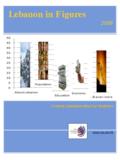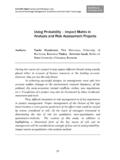Transcription of Measuring poverty in Lebanon using 2011 HBS - …
1 Measuring poverty in Lebanon using 2011 HBS Technical report CENTRAL ADMINISTATION OF STATISTICS (CAS) AND THE WORLD BANK December 8, 2015 This technical report is a joint effort of the Central Administration of Statistics of Lebanon and the World Bank. The report is a product of the World Bank s programmatic work in Lebanon and technical assistance. The CAS team includes Najwa Yaacoub and Mayssaa Daher. The World Bank team consists of Tara Vishwanath, Dean Jolliffe and Aziz Atamanov. The team received guidance and comments from Benu Bidani (Practice Manager, GPVDR). The team is also thankful for useful comments from Ken Simler (peer reviewer), Sailesh Tiwari (peer reviewer), Nobuo Yoshida (peer reviewer), Tara Vishwanath, Sergio Olivieri, Nandini Krishnan and Gabriel Lara Ibarra.
2 We are also grateful to Jacob Goldston for a careful cross review of all the Stata code. 2 Contents 1. Introduction and country context .. 4 2. Methodological issues in poverty measurement .. 5 3. Welfare aggregate and its components .. 7 Data issues .. 7 Food items .. 9 Non-food items .. 11 Rents .. 11 Durables .. 13 Education and health .. 14 Adjustments to welfare aggregate .. 15 Spatial adjustment .. 15 Inter-temporal adjustment .. 18 Adjustment to household size .. 19 4. Construction of poverty 19 Food poverty line .. 20 Non-food component of poverty line .. 21 5. Supplemental information .. 23 Robustness tests of poverty rates based on consumption per capita.
3 23 Supplementary poverty rates based on consumption per adult equivalent .. 27 6. Concluding remarks and further steps .. 30 References .. 32 Annex .. 33 Tables Table 1. OLS regression for different rent values in logarithms .. 12 Table 2. Annualized consumption flow from transportation by quintiles .. 14 Table 3. Example of calculation of food deflator .. 16 Table 4. Predicted rent, nonfood and food deflators .. 18 Table 5. Daily per capita calorie intake and costs in 2004 and 2011 .. 20 Table 6. Daily per capita consumption of selected products, in grams or milliliters .. 21 3 Table 7. poverty in Lebanon , 2011 /2012 .. 22 Table 8. Source of income across quintiles, %.
4 26 Table A1. COICOP items taken from individual 33 Table A2. COICOP durable items excluded from welfare aggregate .. 33 Table A3. Inequality measures by regions .. 34 Table A4. Regional poverty in Lebanon , 2011 /2012 .. 34 Table A5. Consumption per capita and shares by COICOP groups and quintiles .. 35 Figures Figure 1. Consumption per capita using rescaled and raw weights .. 8 Figure 2. Timing of survey in different regions .. 8 Figure 3. Daily purchases of selected products in three regions .. 8 Figure 4. Cumulative distribution function of imputed and actual purchases for responders and non-responders .. 10 Figure 5. Nominal annual consumption per capita using different imputation techniques, thou.
5 LBP .. 10 Figure 6. Regional distribution of households reporting actual rent .. 11 Figure 7. Impact of excluding rent on welfare aggregate .. 13 Figure 8. Shares of products by number of unit measures, %.. 15 Figure 9. Unit measures for selected products .. 16 Figure 10. Spatial food deflator by regions, index .. 17 Figure 11. Nominal and spatially adjusted welfare aggregate .. 18 Figure 12. poverty rates by regions .. 22 Figure 13. Welfare aggregate, poverty line and self-assessed income per capita across quintiles .. 24 Figure 14. Self-assessment of households across welfare status, % .. 25 Figure 15. Number of months without income across quintiles, % .. 25 Figure 16. Ownership of cars across quintiles, %.
6 25 Figure 17. Ownership of computers across quintiles, % .. 25 Figure 18. poverty rates for different reference groups .. 26 Figure 19. poverty rates, including and excluding health 27 Figure 20. poverty rates, including and excluding durables .. 27 Figure 21. poverty rates using different poverty lines .. 27 Figure 22. Cumulative distribution consumption per capita and poverty lines .. 27 Figure 23. Consumption in per capita and adult equivalent terms .. 29 Figure 24. poverty rates based on consumption per capita and adult equivalent .. 30 4 1. Introduction and country context According to World Bank Development Indicators, Lebanon is anupper middle income country with an estimated population of million people and GDP per capita of 17,462 USD in 2014 (based on 2011 PPPs).
7 The country is well known for its high level of human development and open economy. Yet, social and economic performance of the country has been moderate during the last 40 years because of numerous domestic and international political and religious shocks including wars with Israel, major political assassinations, waves of terrorism activities, and spillovers from regional conflicts the latest being the Syrian conflict. Understanding how changes in the country both positive and adverse factors -- have affected the population requires a timely and accurate statistical foundation. Lebanon is a sectarian-based consensual democracy, where population demographics are a particularly sensitiveand political issue.
8 The timely collection of social, economic and demographic statistics is a difficult task in any environment, but it is all the more challenging in Lebanon where demography is directly linked to governance. In part due to these challenges, the last official census in Lebanon was conducted in 1932, and the latest update of the population estimate was made in 1964, drawing on civil status registers within the Ministry of the Interior (European Union, 2009). The Ministry of Social Affairs, supported by the United Nations Development Program (UNDP), and in partnership with the Central Administrationof Statistics (CAS), undertook the first multipurpose household survey (living conditions and household budget survey).
9 This socio-economic survey was conducted during February 2004 to April 2005 on about 13,000 households distributed nationwide. The sample covered the whole de facto population, except the Palestinian population living in the refugee camps. This data was used to construct a lower, extreme poverty line as well as an upper poverty line, both of which were used to produce measures of absolute poverty . CAS received technical support from World Bank staff on the construction of welfare aggregate, and technical support from UNDP on the estimation of household-specific poverty lines. UNDP (2008) provides a full description of the methodology and the profile of poverty in Lebanon as portrayed by the 2004-05 data.
10 Eight percent of the Lebanese population were estimated to be in extreme poverty ( below the extreme poverty line), essentially not able to meet their most basic food and nonfood needs in 2004/2005. An estimated percent of the population were poor as defined by the upper poverty line. Striking differences in consumption per capita and headcount poverty rates were identified across regions with the North Lebanon , South and Bekka being the poorest. The second household budget survey (HBS) was implemented by CAS in 2011 with technical assistance from the World Bank. In addition to meeting the core statistical needs of the government to understand the overall wellbeing of the population, the data was also needed to create a baseline for evaluating the impact of the National poverty Targeting program, to update the proxy means test used for this program, and more generally to develop a social protection and human development strategy.






